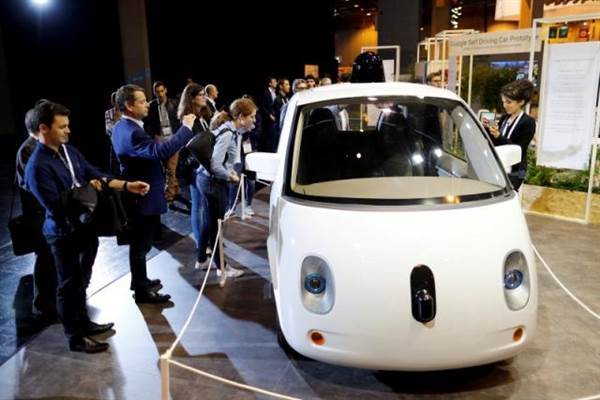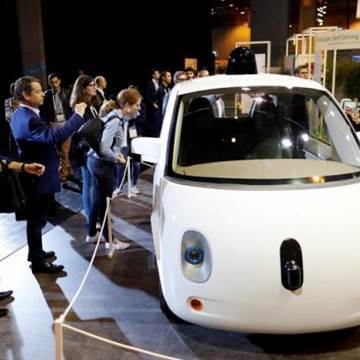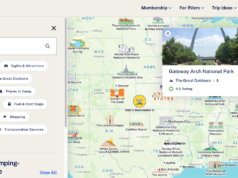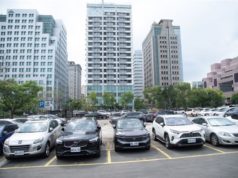Crawling through rush hour traffic is probably the last thing you’re looking forward to on a Monday. So how about tapping an app on your smartphone and heading out the door and into a new Mercedes-Benz robo-cab?
That’s the vision behind a new joint venture between Mercedes’ parent Daimler AG and German auto supplier Bosch. The project, announced earlier this week, is aimed at putting fully driverless cabs on the road by 2021, the partners explaining that, “The idea… is that the vehicle will come to the driver, not the other way around.”
As we head towards the end of the decade, a concept that was long the stuff of science fiction seems set to become everyday reality — and faster than many had expected. Virtually every major automaker — along with an assortment of industry suppliers and some non-traditional players like Google parent Alphabet — are racing to put not only autonomous, but even fully driverless, vehicles on the road.


How soon remains a topic of debate. Several of the contenders claim they’ll be there before 2020. Others are targeting early to mid-decade. Skeptics, meanwhile, point to a pair of recent crashes involving autonomous prototypes and warn the path to autonomy is nowhere near as smooth as it might seem.
From Assisted Driving…
What manufacturers will bring to market — and who they’ll target with these high-tech cars — is also a matter of dispute. Cars with semi-autonomous features, such as forward collision warning with auto-braking, are already in wide distribution, but the term, “autonomous vehicle” covers a lot of ground. Not all self-driving vehicles are going to be equal. And some of the most advanced may be so expensive they’ll only be aimed at ride-sharing and delivery service fleets, rather than retail customers, experts warn.
Industry trade groups rank autonomous technologies by their levels of capabilities, starting with Level 1, vehicles that can assist the driver in avoiding accidents, though the human is always in charge. These systems are already in widespread use on even some mid-priced models, like the Ford Fusion and Toyota Camry.
Level 2 systems allow drivers to briefly take hands off the wheel, though usually on well-marked, limited-access highways. And the driver must be ready to retake control at a moment’s notice. Think Tesla’s Autopilot. Volvo is offering similar technology on its new XC90, S90 and V90 models, while Mercedes-Benz is in the loop with its newly updated E-Class.
Level 3 moves things up a notch, allowing the vehicle to travel hands-free in most situations though, again, an “operator” will still need to be ready to take over in an emergency. Tesla promises to upgrade Autopilot to this level by the end of the decade. Nissan says it will have Level 3 models in production by 2020, and several other automakers will be close behind.
… to Completely Driverless
Now comes the real technological magic. Level 4 vehicles will not require a human behind the wheel. In fact, there may not even be a steering wheel, pedals or other driver controls. These completely driverless vehicles will, however, be “geo-fenced,” a fancy way of saying there’ll be limits to where they can operate, and when. They may be restricted in bad weather, especially heavy snow and ice.
Level 5 goes all the way. These are the robo-cars, cabs and trucks of sci-fi, able to operate anytime, anyplace, without human intervention.
Mercedes and Ford are both promising to put fully driverless vehicles on the road by 2021. The early ones may have some limits — Level 4 capabilities — but the goal is to reach full Level 5 soon after. Meanwhile, Waymo, the Google spin-off that has clocked millions of miles with its fleet of autonomous vehicles, is getting ready to start testing fully driverless models in the coming months.
Related: Tesla Autopilot Begins Braking Before Wreck
At least, those are the plans. A new study by Navigant Research rates how manufacturers are faring in the autonomous race. It puts Ford first, closely followed by General Motors, Daimler and the Renault-Nissan Alliance. Surprisingly, Waymo, which has traditionally been viewed as the field’s leader, slips closer to mid-pack in the study.
Why Tech Companies Are No Longer in the Lead
“On the tech side (Waymo) gets a very high score,” Navigant researcher Sam Abuelsamid told NBCNews. “But what they don’t have is a production strategy. They don’t have a pathway to produce vehicles or distribute them.”
Struggling to find a way to get autonomous technology actually out onto the road is one reason why experts like Abuelsamid believe Apple decided to scale back its own, secretive car program, which had gone by the codename Project Titan.
Not everyone agrees on how to put autonomous and fully driverless vehicles on the road. Lower level technologies will certainly find its way to your local showroom, albeit carrying a price premium that could run into the thousands of dollars. Even Level 3 systems could go into retail distribution, though -‘s where the debate starts to intensify.
Most experts believe that vehicles that smart will require a mix of radar, sonar, camera and LIDAR — high-definition, 3D laser — sensors, like those found on the latest Waymo prototype unveiled in January, a heavily modified Chrysler Pacifica Hybrid minivan. By taking production of LIDAR sensors in house, Waymo has cut their cost to $7,000 apiece, but the vehicles need four each. To be affordable for the masses, that would have to come down by at least another order of magnitude.
Related: Riding Along in Ford’s Autonomous Fusion
That’s why many experts anticipate the real market for autonomous vehicles won’t be the typical consumer. Like Mercedes, Ford last year said its driverless vehicles will be aimed, at least initially, at ride-sharing and delivery fleets. If costs do fall enough, retail models could follow.
…







